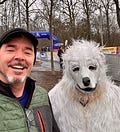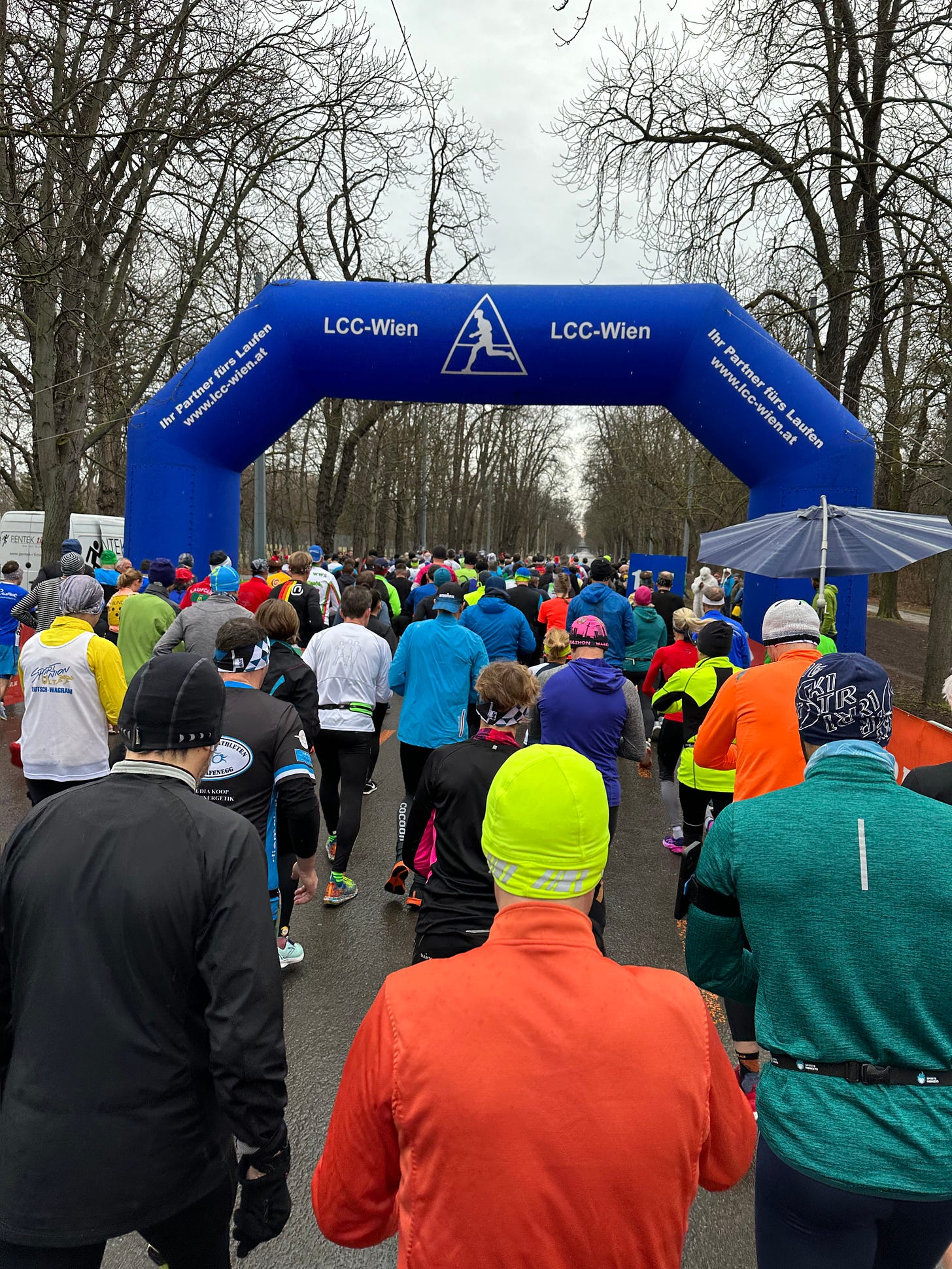Checkpoint Race for 2023 - The Eisbârlauf Half Marathon (Vienna, AT)
Why "a no clock race" is a good starting point for the season
Last Sunday, I had my first race of the year at the Eisbärlauf (Polar Bear Run) Half Marathon here in Vienna, Austria. This was a “checkpoint race”, meaning I ran the race without looking at the clock/watch, and with no specific training to prepare for it. I find this is a helpful way to gauge my current fitness level at the start of the year, and best understand where my weak spots are. Despite the cold and wet conditions, it turned out to be a great day to run!
(Hanging out with the Eisbärlauf mascot…and after seeing his/her face, feeling the need to apply moisturizer more often)
As a middle-aged masters runner (age 53), one never knows how these checkpoint races will go. I’ve been consistently running, but not really training for anything specific since COVID wiped out both me and my race calendar last Summer. But it appears there are no long-term COVID issues, and I’m in a comfortable habit of regular running with weekend long runs. But for me, a span of no races generally means less focus on the speed/weight training discipline that is needed to hold off the inevitable decline in strength and aerobic capacity that comes with aging (2-4%/year). For this Eisbärlauf, I had no expectations - in fact, the main point of the first checkpoint race is to ensure you benchmark your goals appropriately. This is particularly important for us masters, whose selective memory often swims in the glory days of yore.
The Eisbärlauf Half is a great checkpoint race - a completely flat loop course, with 7k/14k/21k options that result in lots of runners at different speeds around you. I have many race formats on the calendar for 2023 (road marathons, trail runs, triathlons, cycling, etc.), but always find a flat half is a great universal benchmark. This particular race is put on by LCC-Wien, one of the larger running clubs in the city, and one of three half marathons this season as part of their Eisbär Cup. For readers who aren’t familiar with European sports clubs, they play a big part in keeping a thriving community for a sport, whether that is running, skiing, football, golf, etc. This includes putting on races and training events, providing coaching, having professional running teams, and youth programs (these youth programs supplement that fact that they don’t really have junior high/high school sports teams like in the USA). There were about 400 runners here today, from age 8 to 80+, and it’s great to see they all generally know each other.
(And we’re off!!!)
A sprinkle of rain and 38F/3C weather greeted us in the start corral, despite the civilized 10am start time that I have come to love with European races. The start/finish was set up on the now-famous section of Prater Park and Amusement area where Eliud Kipchoge broke the 2-hour marathon barrier a few years ago. The lead pack of runners channeled this energy when the gun went off, setting a 1 hr 15 min half marathon pace. I jogged 1km, then settled into a quick rhythm a few groups behind them, turning over my adidas adizero Pro 3 shoes while dodging puddles.
First and second 7k loops felt consistent, but I could tell my limiter was my strength. I just wasn’t leaning forward like one does when you have developed your power, nor did I have that caged-animal-set-free energy that you get when you taper off a training block. But everything else seemed to be holding up well. No niggles, relaxed shoulders, and able to sing along with my tunes.
(Out and back, watching the clothing layers get stripped down)
On the third 7k loop, I pushed up to my 10k pace, only to have my stomach and intestinal tract give me a big “HELL NO” that required a slow down. I could also feel my breathing got very sharp, very quickly (VO2 Max limiter). A good reminder that speed work trains more than just your legs - it helps your entire body prepare for the full range of gears.
I crossed the finish line as the clock hit 1 hr 32 minutes, and my watch showed 18 consistent km’s at 4:23-4:25/km (just under a 7 min/mile). Good news - still relatively fast, good consistency, legs feel good, and no soreness that would indicate imbalanced or weak zones. Given previous years, this should be enough to get to a sub-3 hour marathon by April if I am disciplined. Areas to improve - need to get that speed work in rotation for sure! And maybe not spicy Korean food the night before. ;-)
Next race is another Eisbärlauf Half Marathon on February 19th. I’ll focus on my limiters between now and then, and will also need to start building a base for cycling and swimming. So it will be interesting to check in again soon and see how this is coming together. Similar to this race, I won’t taper down or train specifically for the #2 checkpoint race. My past years of training would indicate a similar or slightly faster pace for #2 is on track, with the speed showing up more clearly in March at race #3. For triathlon training, it will be February when I see the first benchmark results for swimming and cycling.
One race down, and much work to do! But I am also content that running still fills me with joy, even in the rain and cold. There’s nothing quite like it to boost your optimism, no matter what your speed or destiny. I look forward to getting that unique satisfaction that comes from embracing the training process and seeing what happens. Perhaps I will see these Eisbär runners again!
Couldn’t think of a better way to start the year…I hope you are all experiencing the same!
Cheers, Scott






You’re still so fast!